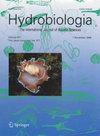1891年墨西哥湾西南部一处暗礁上阿兹特克对虾的mysis密度
IF 0.3
4区 生物学
Q4 MARINE & FRESHWATER BIOLOGY
引用次数: 0
摘要
背景Parque Nacional Sistema Arrecial Veracruzano(PNSAV)位于墨西哥湾南部,支持以三种树鳃亚目为基础的重要虾业:棕色虾、阿兹特克对虾、白色虾、刚毛P.setiferus和粉红色虾、双棘P.duorarum。客观的分析阿兹特克P.aztecus在mysis阶段的分布和丰度,并确定其与PNSAV中环境因素的关系。方法。我们在现场测量了温度、盐度和溶解氧。来自四个样带的浮游生物样本是在2011年至2013年的冷锋和雨天条件下采集的。后果在多雨条件下,温度从27.49±0.46变化到29.98±0.02°C,盐度从32.18±0.06变化到35.40±0.52,溶解氧从3.64±0.13变化到6.18±0.64 mgL-1;在冷锋期间,温度从23.21±0.05变化到25.74±0.37°C,盐度从34.59±0.39变化到35.84±0.17,溶解氧从4.04±0.06变化到6.02±mgL-1。2011年雨季,南部样带近海岸的平均密度最高,为6938±326 mysis 100 m−3,其次是2013年冷锋天气条件下的离岸中央样带3321±339 mysis 100米−3,2011年冷锋气候条件下的中南部前滨样带3056±236 mysis 100 m-3。结论。在mysis阶段,P.aztecus的最高密度记录在PNSAV的南部前滩地区,在下雨条件下,并且与溶解氧浓度的大值有关。本文章由计算机程序翻译,如有差异,请以英文原文为准。
Density of mysis of Penaeus aztecus Ives, 1891 on a reef in the Southwest of the Gulf of Mexico
Background. The Parque Nacional Sistema Arrecifal Veracruzano (PNSAV) is in the southern Gulf of Mexico and supports an important shrimp fishery based on three species of Dendrobranchiata: the brown shrimp, Penaeus aztecus, the white shrimp, P. setiferus and the pink shrimp, P. duorarum. Objective. Analyze the distribution and abundance of P. aztecus during the mysis stage and determine its relationship with environmental factors in the PNSAV. Methods. We measured temperature, salinity, and dissolved oxygen in situ. The planktonic samples from four transects were collected during cold fronts and rainy weather conditions from 2011 to 2013. Results. In rainy conditions the temperature varied from 27.49 ± 0.46 to 29.98 ± 0.02°C, salinity from 32.18 ± 0.06 to 35.40 ± 0.52, and dissolved oxygen from 3.64 ± 0.13 to 6.18 ± 0.64 mgL-1; during cold fronts the temperature varied from 23.21 ± 0.05 to 25.74 ± 0.37 °C, salinity from 34.59 ± 0.39 to 35.84 ± 0.17, and dissolved oxygen from 4.04 ± 0.06 to 6.02 ± mgL-1. The highest average density with 6,938 ± 326 mysis 100 m−3, was found during rainy season in 2011 in the southern transect nearshore, followed by 3,321 ± 339 mysis 100 m−3 in the offshoresouth-central transect during cold fronts weather conditions in 2013, and 3,056 ± 236 mysis 100 m−3 in the south-central foreshore transect during cold fronts weather condition in 2011. Conclusions. The highest density of P. aztecus during mysis stage was recorded in southward foreshore area from PNSAV, during rainy conditions and related to large values of dissolved oxygen concentrations.
求助全文
通过发布文献求助,成功后即可免费获取论文全文。
去求助
来源期刊

Hidrobiologica
生物-海洋与淡水生物学
CiteScore
0.40
自引率
0.00%
发文量
8
审稿时长
>12 weeks
期刊介绍:
HIDROBIOLÓGICA es una publicación cuatrimestral que difunde trabajos originales e inéditos de investigación o revisión, sobre temas relacionados con los organismos y la hidrología de los ambientes acuáticos, dulces y marinos y va dirigida a investigadores de todo el mundo, interesados en las diversas disciplinas que incluye la Hidrobiología , así como a alumnos de posgrados y licenciaturas relacionados con la biología, ecología, taxonomía, filogenia y evolución de organismos acuáticos, e hidrología y oceanografía de ambientes s dulceacuícolas y marinos.
 求助内容:
求助内容: 应助结果提醒方式:
应助结果提醒方式:


